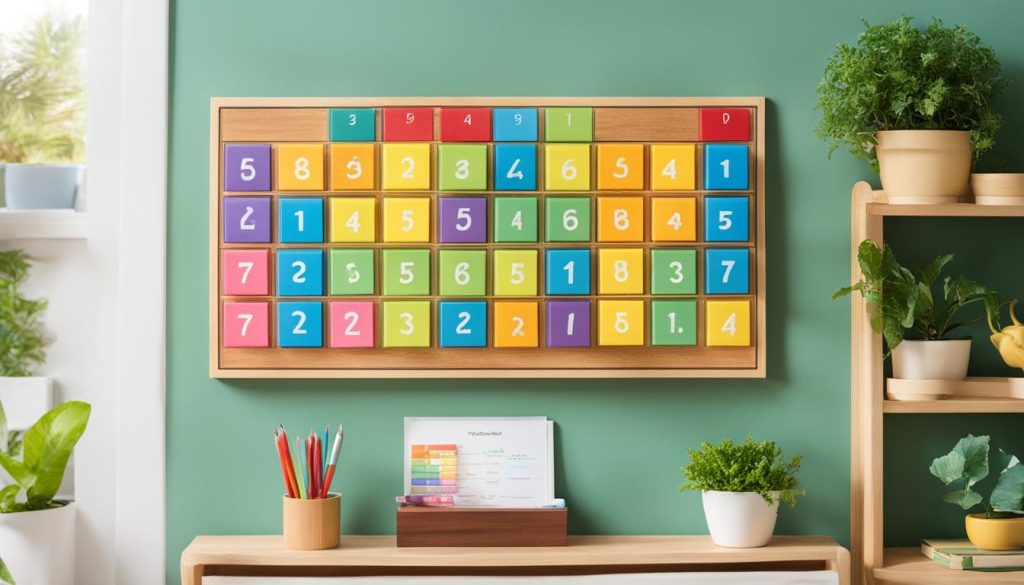As a homeschool evaluator and a homeschool mom for 20 years, I have seen many different types of homeschool schedules that families have successfully implemented. Creating an effective weekly schedule can look different for each family, depending on their needs and preferences. In this article, I will provide you with tips and strategies to help you craft a seamless home school schedule that maximizes learning and flexibility.
Key Takeaways:
- Create a customized homeschool schedule based on your family’s needs and preferences.
- Consider different types of homeschool schedules, such as traditional, subject-focused, or co-op-based.
- Establish a family vision or mission statement to guide your homeschool schedule creation.
- Set goals for homeschooling success and tailor them to your child’s learning style and interests.
- Evaluate your family’s needs and preferences, including work schedules and outside activities, when designing your homeschool schedule.
Tips for Creating a Customized Homeschool Schedule
When it comes to homeschooling, creating a customized schedule that fits your family’s needs and preferences is key to success. By taking a thoughtful approach and considering a few important factors, you can design a homeschool schedule that maximizes learning and flexibility.
Evaluate Your Family’s Activities and Commitments
Before diving into creating your homeschool schedule, it’s crucial to have a broad view of your family’s weekly and monthly activities. Take into account both academic and non-academic commitments and responsibilities. This will help you get a clear picture of your available time slots for homeschooling.
Consider Consistency vs. Flexibility
While some families prefer a consistent daily schedule, others thrive on flexibility. Assess your family’s needs and decide which approach works best for you. If consistency is important, allocate specific time blocks for different subjects or activities. If flexibility is a priority, create a more fluid schedule that allows for spontaneous learning experiences.
Start with One Academic Subject at a Time
When crafting your homeschool schedule, it can be helpful to start with one academic subject at a time before gradually adding more. This allows you to focus on building a solid foundation in one area before expanding your curriculum. It also helps prevent overwhelming both you and your child with a packed schedule.
Avoid Overloading Your Schedule
It’s essential to be realistic and avoid overloading your homeschool schedule. Remember that flexibility and breaks are crucial for maintaining a healthy balance. Be mindful of the time and energy required for each subject and activity, ensuring that you have enough breathing room in your schedule.
Utilize a Homeschooling Planner or Timetable
To stay organized and keep track of your homeschool schedule, consider using a homeschooling planner or timetable. These resources provide a visual representation of your daily, weekly, and monthly schedule, making it easier to manage your time effectively. You can find printable planners or use digital tools to customize your own.
“Creating a homeschool schedule that caters to your family’s needs and preferences is the key to a successful homeschooling journey. By evaluating your activities, considering flexibility, starting with one subject at a time, avoiding overload, and utilizing a homeschooling planner or timetable, you can create a customized schedule that fosters a positive learning environment for your child.”
| Benefits of a Customized Homeschool Schedule |
|---|
| Allows for flexibility and spontaneity. |
| Reduces stress and overwhelm. |
| Maximizes learning opportunities. |
| Promotes a healthy work-life balance. |
Different Types of Homeschool Schedules
When it comes to homeschooling, there is no one-size-fits-all approach. Families have the flexibility to create a schedule that suits their unique needs and preferences. Here are some different types of homeschool schedules to consider:
- Traditional Five-Day Schedule: This schedule follows the typical five-day school week, where multiple academic subjects are covered each day. It provides structure and consistency in daily learning.
- Four-Day Schedule: Some families opt for a four-day schedule, reserving the fifth day for other activities or field trips. This allows for more flexibility and the opportunity to explore hands-on learning experiences outside the home.
- Subject-Focused Schedule: This type of schedule focuses on one academic subject each day, allowing for a deep dive into the topic. It provides ample time for in-depth study and exploration.
- Subject-Dedicated Days: For families who prefer a balanced approach, dedicating each day to a different subject can be an effective option. This ensures that all subjects are covered regularly while providing variety in the daily routine.
- Co-Op or University-Model Schedule: Some families structure their schedule around academic co-ops or university-model homeschool co-ops. These programs offer a combination of at-home and on-site learning, providing a collaborative and supportive environment for both students and parents.
By exploring these different types of homeschool schedules, you can find the one that offers the right balance of structure and flexibility, aligning with your family’s needs and preferences.

Benefits of a Flexible Homeschool Schedule
“Flexibility is one of the greatest advantages of homeschooling. It allows families to tailor their schedule to accommodate various commitments and interests.”
A flexible homeschool schedule offers numerous benefits, such as:
- Customized Learning: With a flexible schedule, you can customize the learning experience based on your child’s unique interests, strengths, and learning style. This personalized approach promotes engagement and a love for learning.
- Balanced Lifestyle: Flexibility enables you to strike a balance between academics, extracurricular activities, and family time. You can allocate time for hobbies, sports, and other interests, fostering holistic development.
- Opportunities for Exploration: A flexible schedule allows for spontaneous learning opportunities and field trips. You can seize the moment to visit museums, parks, and community events, enhancing the educational experience.
- Individualized Pace: Homeschooling with a flexible schedule lets you adjust the pace of learning to suit your child’s needs. You can spend more time on challenging subjects or accelerate through materials based on proficiency levels.
A flexible homeschool schedule empowers you to create an education that not only meets academic goals but also nurtures your child’s passion for learning.
The Importance of a Family Vision or Mission Statement
Before diving into creating a homeschool schedule, it’s essential to establish a family vision or mission statement. This statement outlines your overall goals and priorities for homeschooling, providing a clear direction for your educational journey. By defining your homeschooling vision and mission, you set the foundation for your child’s learning and development.
When crafting your homeschooling vision, reflect on what you hope to achieve through homeschooling. Consider the values, principles, and beliefs that guide your approach to education. What do you want your child to gain from their homeschool experience? Your homeschooling vision should encapsulate these aspirations, serving as a compass for your decision-making process.
Similarly, your homeschooling mission statement outlines the specific objectives and actions you will take to fulfill your vision. It clarifies the steps you’ll follow and the resources you’ll utilize to achieve your desired outcomes. Your mission statement helps you prioritize what’s essential to include in your homeschool schedule, ensuring you stay focused on your goals.
Creating a family vision or mission statement involves involving all members of the family, discussing and aligning your goals and values. This collaborative process fosters strong family bonds and cultivates a sense of purpose in your homeschooling journey.
“A clear vision, backed by definite plans, gives you a tremendous feeling of confidence and personal power.” – Brian Tracy
The Benefits of a Homeschooling Vision and Mission Statement
Developing a family vision or mission statement for homeschooling has several benefits:
- Guidance and Direction: A vision and mission statement provide a roadmap for your homeschooling journey, helping you make decisions in line with your goals.
- Focus and Prioritization: It enables you to identify and prioritize the important aspects of your child’s education, ensuring you allocate time and resources accordingly.
- Motivation and Inspiration: A clearly defined vision and mission statement inspire you and your child to pursue learning with enthusiasm, fostering a positive and engaging homeschool environment.
- Alignment with Values: Your vision and mission statement ensure that your homeschooling approach aligns with your family’s values and beliefs, providing a consistent and meaningful educational experience.
Crafting a homeschooling vision and mission statement is an investment in the future of your child’s education. It sets the stage for a purposeful and intentional homeschool experience, guiding you through the challenges and triumphs of homeschooling.
Setting Goals for Homeschooling Success
Setting goals is a vital aspect of homeschooling that contributes to your child’s academic progress and personalized learning experience. By establishing clear goals for each subject and skill area, you can track their development and ensure that your homeschool schedule aligns with their educational needs.
When setting goals, it’s important to consider different aspects of your child’s education. Whether they need to improve their math skills, foster their creativity, or enhance their critical thinking abilities, goal setting provides a roadmap for their educational journey.
“Setting goals is the first step in turning the invisible into the visible.” – Tony Robbins
By tailoring these goals to your child’s learning style and interests, you can create a homeschool experience that is engaging, meaningful, and tailored to their unique needs. Personalized learning goals empower your child to take ownership of their education and promote a sense of motivation and achievement.
Academic Goals
Academic goals are focused on your child’s progress in core subjects such as mathematics, language arts, science, and social studies. These goals can be specific to each subject area to ensure comprehensive skill development.
For example:
- Mathematics: Improve problem-solving skills and mastery of multiplication tables.
- Language Arts: Enhance reading comprehension and vocabulary expansion.
- Science: Develop a deeper understanding of scientific concepts through hands-on experiments and observation.
- Social Studies: Explore different cultures and historical events to foster a broader worldview.
Personalized Learning Goals
Personalized learning goals focus on your child’s individual strengths, interests, and passions. These goals allow them to explore areas of knowledge that align with their personal aspirations and ignite a love for lifelong learning.
For example:
- Creative Arts: Cultivate artistic abilities through painting, drawing, or playing a musical instrument.
- Physical Education: Improve physical fitness and develop fundamental movement skills through sports and exercise.
- Computer Science: Learn programming languages or explore web design to foster digital literacy.
- Life Skills: Develop practical skills such as cooking, budgeting, or time management.
Remember, setting goals is just the first step. Regularly reviewing and assessing the progress of these goals ensures that your homeschooling approach remains effective and aligned with your child’s learning needs.

| Subject | Academic Goals | Personalized Learning Goals |
|---|---|---|
| Mathematics | Improve problem-solving skills and mastery of multiplication tables. | Explore mathematical concepts through puzzles and real-world applications. |
| Language Arts | Enhance reading comprehension and vocabulary expansion. | Write and publish short stories or start a personal blog to foster writing skills. |
| Science | Develop a deeper understanding of scientific concepts through hands-on experiments and observation. | Conduct independent research on a scientific topic of interest and present findings. |
| Social Studies | Explore different cultures and historical events to foster a broader worldview. | Create a family tree and explore personal heritage and ancestry. |
Evaluating Your Family’s Needs and Preferences
Every family is unique, and when it comes to homeschooling, it’s crucial to consider your family’s specific needs and preferences. One size does not fit all when it comes to creating a homeschool schedule that works for everyone involved. Take the time to evaluate your current routines, work schedules, and outside activities to ensure that your homeschool schedule fits seamlessly into your daily life.
Consider the following factors when evaluating your family’s needs and preferences:
1. Routines:
Take a closer look at your current daily routines. Identify any fixed commitments or responsibilities that must be accounted for in your homeschool schedule. For example, if you have a morning exercise routine that you don’t want to interrupt, you may want to schedule homeschooling in the afternoon or evening.
2. Work schedules:
Consider your work schedules and how they align with your homeschooling plans. Determine the hours when you and your spouse are available to provide instruction or support. If both parents work full-time, you may need to explore options such as asynchronous learning or hiring a tutor to assist with certain subjects.
3. Outside activities:
Think about your child’s involvement in extracurricular activities, such as sports, music lessons, or community programs. Ensure that your homeschool schedule allows time for these activities without overwhelming your child or causing conflicts. Balancing academics with outside interests is key to a well-rounded homeschool experience.
By taking into account your family’s specific routines, work schedules, and outside activities, you can design a homeschool schedule that accommodates everyone’s needs and preferences. Customizing your schedule in this way will help create a harmonious learning environment for your child.
| Factors to Consider | Questions to Ask |
|---|---|
| Routines | What are your family’s current daily routines? Are there any fixed commitments or responsibilities? |
| Work schedules | What are your work schedules? When are you and your spouse available to provide instruction or support? |
| Outside activities | What extracurricular activities is your child involved in? How much time should be allocated for these activities? |

“Creating a homeschool schedule isn’t just about academics; it’s about encompassing the unique dynamics and commitments of your family. By evaluating your family’s needs and preferences, you can design a schedule that allows for a seamless integration of homeschooling into your daily life.”
The Importance of Flexibility in Your Homeschool Schedule
Flexibility is a key component of successful homeschooling. Unlike traditional school schedules, homeschool schedules should allow for unexpected events and opportunities. It’s important to build in flexibility to accommodate interruptions or spontaneous learning experiences. Whether you choose a structured schedule or a more flexible routine, remember to allow room for adjustments and changes as needed. A homeschool schedule should be adaptable to the ever-changing needs of your family.
Flexibility in your homeschool schedule allows you to:
- Seize Learning Opportunities: With a flexible homeschool routine, you can take advantage of impromptu field trips, guest speakers, or interesting events happening in your community. These unplanned experiences can enhance your child’s learning and provide valuable real-world connections.
- Prioritize Family Time: Homeschooling gives you the freedom to create a schedule that allows for quality family time. Whether it’s taking breaks to share meals together or scheduling regular family activities, flexibility lets you put family bonding at the forefront.
“Flexibility is the cornerstone of homeschooling. It allows you to adapt to the needs of your child and explore unique learning opportunities together.”
You can maintain flexibility in your homeschool schedule by:
- Creating Buffer Time: Allocate extra time between subjects or activities to provide breathing room. This buffer time allows for unexpected interruptions or extensions for in-depth exploration of topics.
- Embracing Spontaneity: Be open to unexpected learning opportunities. If your child shows a sudden interest in a particular topic or asks thought-provoking questions, deviate from your schedule and dive deeper into that subject.
- Adjusting as Needed: Regularly assess and adjust your homeschool routine to meet your family’s changing needs. What worked in the past may not be effective in the future, and that’s okay. Flexibility allows you to adapt and find the best approach for your child’s learning journey.
Remember, homeschooling is about creating an optimal learning environment that suits your family’s unique dynamics and aspirations. A flexible schedule empowers you to tailor education to your child’s individual needs and interests, fostering a love for lifelong learning.

Creating a Productive Learning Space for Homeschooling
A productive learning space is crucial for your homeschooling journey. When designing your child’s learning area, it’s essential to consider their unique learning style and preferences. Pay attention to factors such as physical location, position, sound, color, and time of day, as these elements can greatly impact your child’s focus and engagement. By providing a personalized learning space, you create an environment that nurtures their individuality and fosters a love for learning.
Evaluate Your Child’s Learning Personality
Each child has a unique learning personality, and their ideal learning environment may vary. Some children thrive in a quiet and organized study area, while others prefer a creative and comfortable retreat. Observe your child’s preferences and adapt their learning space accordingly. This personalized approach will create a space where they feel comfortable and motivated to learn.
Choose the Perfect Location
The physical location of the learning space plays a vital role in your child’s productivity. Consider finding a quiet and well-lit area free from distractions. A dedicated room or a quiet corner of your home can provide the necessary focus for effective learning.
Create a Comfortable and Ergonomic Setup
Make sure your child’s learning area is set up in a manner that promotes good posture and comfort. Provide a suitable desk or table and an ergonomic chair to support their body during study sessions. An organized workspace also helps maintain focus and prevents clutter from becoming a distraction.
Consider Learning Preferences
Take into account your child’s learning preferences when designing their space. If they are visual learners, incorporate educational posters, charts, or maps on the walls. If they prefer auditory learning, provide access to audiobooks or a small sound system. Adapt the space to accommodate their preferred learning modalities for an enriched educational experience.
Set Clear Boundaries
Establish clear boundaries for the learning space. Communicate to your child that this area is exclusively for studying and learning. This helps create a sense of focus and encourages them to differentiate between study time and leisure time.
Create a Calming Atmosphere
The ambiance of the learning space can significantly impact your child’s concentration. Choose colors, lighting, and decor that promote calmness and focus. A well-designed space with soothing colors and adequate lighting can positively influence your child’s mood and productivity.
Remember the Importance of Personalization
Personalize the learning space to make it unique and inviting for your child. Display their artwork, achievements, or special projects. Incorporate elements that reflect their interests and passions, creating a space that cultivates their individuality and sparks their curiosity.
In conclusion, when creating a productive learning space for homeschooling, consider your child’s learning style, preferences, and interests. By designing a personalized learning area that caters to them, you provide an environment that fosters focus, engagement, and a love for learning.
Tips for Maximizing Learning in Your Homeschool Space
When it comes to homeschooling, creating an optimal learning environment is crucial for your child’s academic success and overall engagement. By implementing practical strategies for homeschool organization, learning space optimization, and utilizing homeschooling resources, you can create an atmosphere that promotes productivity and fosters a love for learning.
Organizing Supplies for Efficiency
To ensure smooth homeschooling sessions, it’s essential to keep your learning area well-organized. By organizing supplies such as textbooks, workbooks, art materials, and stationary, you can minimize distractions and save valuable time. Consider using labeled storage bins, shelves, or a dedicated bookshelf to keep everything easily accessible for both you and your child.
Establishing a Daily Routine
Structure and routine play a vital role in homeschooling. By establishing a daily routine, you can set clear expectations and create a sense of stability and predictability for your child. Dedicate specific times for subjects, breaks, and other activities to maintain a balanced schedule. Having a routine helps your child develop self-discipline and helps you stay organized and focused on teaching.
Maximizing Resources for Enhanced Learning
Take advantage of the plethora of homeschooling resources available to enrich the learning experience. Incorporate educational books, posters, maps, and audiobooks that align with your child’s curriculum. Online platforms, educational websites, and virtual learning tools can also provide interactive and engaging learning opportunities. Providing a variety of resources stimulates curiosity and encourages independent exploration.
Creating a Comfortable Learning Space
Your child’s learning environment greatly impacts their engagement and focus. Design a comfortable and inspiring learning space that caters to their unique learning style. Consider factors such as lighting, seating, and decor that create a positive atmosphere. Ensure that the learning area is free from distractions and conducive to concentration.
Embracing Flexibility for Personalized Learning
While structure and routine are important, it’s also crucial to embrace flexibility in your homeschooling journey. Each child has unique learning needs and interests, so be open to incorporating personalized learning approaches. Adjust your homeschool schedule and learning space according to your child’s preferences and individual progress. Flexibility encourages adaptability and nurtures a love for learning on your child’s terms.
By implementing these tips for homeschool organization, learning space optimization, and utilizing homeschooling resources, you can create an environment that maximizes learning potential and ensures a fulfilling homeschooling experience for both you and your child.
| Benefits of Homeschool Organization and Optimization | Tips for Implementation |
|---|---|
| 1. Minimizes distractions | 1. Use labeled storage bins to keep supplies organized |
| 2. Saves time and increases efficiency | 2. Establish a designated learning area |
| 3. Promotes a sense of order and structure | 3. Create a daily routine |
| 4. Encourages independence | 4. Incorporate a variety of educational resources |
| 5. Enhances focus and concentration | 5. Design a comfortable and inspiring learning space |
| 6. Facilitates personalized and adaptive learning | 6. Embrace flexibility in your homeschooling approach |
The Importance of Flexibility and Adaptation in Your Homeschool Schedule
Creating a homeschool schedule requires careful planning and consideration, but it’s important to remember that adjustments may be needed over time. As your child grows and their interests and learning needs evolve, you must be prepared to make changes to your schedule. Homeschool schedule adjustments allow you to tailor your child’s education to their unique requirements and ensure they continue to thrive.
One of the key advantages of homeschooling is the flexibility it offers. Unlike traditional school settings, homeschooling allows you to adapt your schedule as needed. Whether it’s incorporating new subjects, altering study times, or introducing extracurricular activities, you have the freedom to adapt your homeschool routine to suit your child’s evolving interests and passions.
Life is full of unexpected changes, and homeschooling provides the ideal platform to teach your child how to adapt to change. By maintaining a flexible and adaptable schedule, you can demonstrate to your child the importance of resilience, problem-solving, and embracing new opportunities. This adaptability not only strengthens their academic abilities but also prepares them for the ever-changing world beyond their homeschooling years.
FAQ
How can I optimize my home school schedule for success?
To optimize your home school schedule for success, start with a broad view of your family’s weekly and monthly activities. Consider consistency, be realistic, and avoid overloading your schedule.
What tips can you provide for creating a customized homeschool schedule?
When creating a customized homeschool schedule, it is important to establish a family vision or mission statement, set goals for each subject and skill area, and consider your family’s needs and preferences.
What are the different types of homeschool schedules I can consider?
You can consider following a traditional five-day school week, a four-day schedule with one day for other activities, focusing on one academic subject each day, or dedicating each day to a different subject.
How important is it to have a family vision or mission statement for homeschooling?
Having a family vision or mission statement for homeschooling is important as it helps you make decisions and prioritize what is important to include in your schedule.
Why is setting goals for homeschooling success important?
Setting goals for homeschooling success helps track progress and ensures that your homeschool schedule supports those goals, while also keeping you focused and motivated.
What should I consider when evaluating my family’s needs and preferences for homeschooling?
When evaluating your family’s needs and preferences for homeschooling, consider your current routines, work schedules, and outside activities that need to be taken into account, as well as your child’s learning style and preferences.
How important is flexibility in a homeschool schedule?
Flexibility is crucial in a homeschool schedule as it allows for unexpected events and opportunities. It is important to build in flexibility to accommodate interruptions or spontaneous learning experiences.
How can I create a productive learning space for homeschooling?
To create a productive learning space for homeschooling, consider your child’s learning style and preferences when setting up their learning area. Pay attention to factors such as physical location, position, sound, color, and time of day.
What tips can you provide for maximizing learning in my homeschool space?
To maximize learning in your homeschool space, organize supplies, create a routine, and utilize educational resources such as books, posters, maps, and audiobooks to enhance the learning experience.
How important is flexibility and adaptation in a homeschool schedule?
Flexibility and adaptation are crucial in a homeschool schedule as your child grows and their interests and learning needs evolve. It is important to be prepared to make changes to your schedule as necessary.






